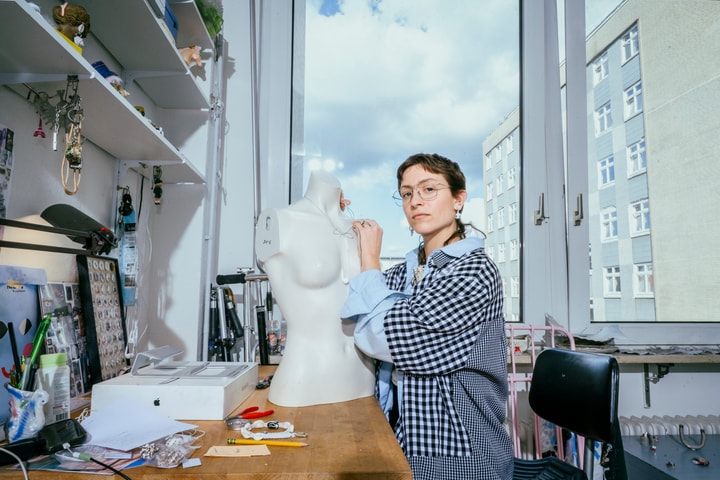In Europe, Dixon is as close as you can get to a household name when it comes to house and techno music. From an illustrious career that first started in the early 1990s, to a legendary Boiler Room set at iconic London venue Printworks (before it sadly shuttered earlier this month), Dixon is a trailblazer in every sense of the word. Known for a diverse body of work that spans across music, fashion and design, Dixon is quietly (or not so quietly) reshaping the way that music is experienced.
The hybrid collective Transmoderna, that he co-founded with its creative director Ana Ofak, serves as an experimental space that blurs the line between physical and digital. As the world of technology continues to make leaps and bounds forward, Transmoderna is leading the charge when it comes to orchestrating an immersive experience that combines music with virtual realities. As a conduit for Dixon, Transmoderna is testing limitations with every performance and becomes a beautiful rendering of music’s ever-changing landscape, a constant ebb and flow that progresses and adapts as its creators continue to test convention and expectations.
We recently got a chance to catch up with Dixon on his latest visit to Hong Kong, a truly electrifying win for the city, having been closed off to the world for the past three years due to strict pandemic-related travel restrictions. Working with HK-based event production company and agency, Spin Sum, Dixon’s visit to Hong Kong created waves within the city’s music scene and introduced it to a cultural giant. “Our Art Basel programming was designed to convey the message of Hong Kong's re-opening to the world post-COVID. We hope that having an industry leader like Dixon as our guest supported that. It's a big statement for the city. While in town, it was a gift to have him shoot with Karim Tabar,” shared Willer, Spin Sum Creative Director and Co-Founder.
Read our conversation below with Dixon as we chat about Chitose Abe, upcoming museum exhibitions and a potential revival of his cult-status clothing brand, Together We Dance Alone.
How did you feel about visiting Hong Kong after the pandemic? Were you inspired by anything from this trip compared to your last stint at Sonar HK 2018?
Seeing Hong Kong coming back to life after the pandemic was a sight to behold. I am grateful that I had the chance to DJ there again during Art Basel and could finally visit the Empty Gallery and M+ Museum on my short trip to the city.
Visuals are such a major component of your sets – were you inspired by any artists during Art Week in HK?
While music is undoubtedly a significant influence for my work as a DJ or producer, it's the unexpected sources of inspiration that often have the most profound impact on my artistic style and vision. In Hong Kong, for instance, I was introduced to the work of the artist Tishan Tsu, and his work triggered some great ideas for my music and our work as Transmoderna.
When you're working on styling editorial projects, is the creative process similar to when you’re creating your music?
As an artist or DJ, I have a foundation that people associate me with. I developed a core identity, a core character, that I always return to. My trademark. But it's important to develop an additional gang of characters, characters that I can trade, that are coming and going while constantly being on the lookout for new and exciting elements to incorporate into my aesthetic, that's what makes it fun for me. Keeping an open mind and staying curious is important, so you will be able to continue to discover new elements that help you evolve your music tastes in exciting ways. The same goes for fashion.
I have my favorite brands and/or designers that I follow and wear for sometimes more than 20 years, like Dries van Noten, Glenn Martens or Chitose Abe. But emerging designers often bring fresh perspectives and new ideas to the table, and they may be more willing to take risks and push boundaries compared to more established brands. By keeping an eye on up-and-coming designers, I am able to stay ahead of the curve and incorporate the latest trends and innovations into my personal style. Of course, not every experiment will be a success – sometimes I'll look back on what I was playing or wearing and wonder, "What was I thinking!" But that's all part of the process, and it's important to be able to laugh at ourselves and learn from our mistakes. It can be tempting to stick to what you know and what you're comfortable with, but true innovation and creativity often come from trying something new and seeing where it takes you.
What's your plan for 2023 moving forward? What are you excited about?
Develop Transmoderna further. Our projects merge electronic music with digital arts. This year is very special due to the fact that we are exhibited in major museums like Centre Pompidou, while at the same time showcasing our visual art and new music at events and festivals. It’s very busy and super satisfying because when we started in 2018, not many understood our ideas. Now, we are able to work with young and established talents alike. Transmoderna has arrived.
You've had collaborations with Sacai in the past with your clubwear line, Together We Dance Alone. Are there any plans to resurface products or partnerships? Are you more focused on digital and experiential happenings nowadays?
Given the closure of clubs and the uncertainty surrounding the future of nightlife, we made the decision to pause our clubwear brand TWDA when the pandemic hit. However, now that clubs are back in most countries, we already starting to bounce around ideas and consider a potential return in 2024!
